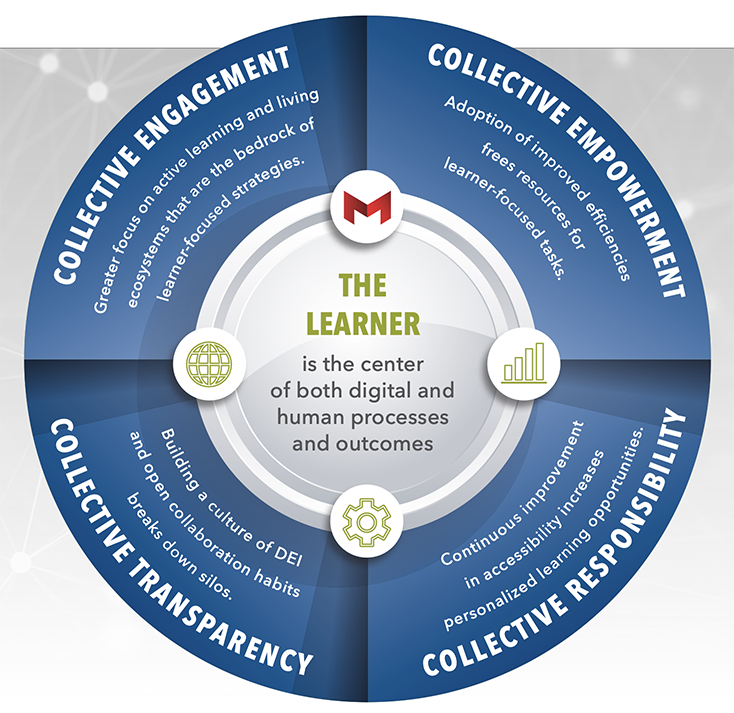Maryville is combining technology and humanology to create the ultimate active learning ecosystem.
As Maryville powers forward with the strategic plan, Maryville 2030 The Access and Opportunity Revolution, “the how” of this plan will develop and evolve, centered around a central concept of collective. Simply put, the success of the plan will be anchored in how Maryville breaks down silos and organizational verticals to promote a culture of collective responsibility and collective action. This transformation has already begun.
For example, at the end of 2022, Maryville dissolved the Information Technology (IT) Department and installed a matrix called the Digital Learning Experience or DLX. The DLX team is made of a collective group of individuals, led by a five-person team, who implement digital strategies across the University with a student-first mindset. From strategic technology investments to software development to next-generation learning tools and AI, DLX follows a strategic priority matrix to manage projects that have the largest impact on the student journey and experience.
Collective technology refers to the integration and collaboration of various technologies, including digital tools, systems and human intelligence (humanology) to collectively address complex problems and achieve common goals. It is a multidisciplinary approach that brings together diverse fields such as AI, machine learning, data analytics, robotics, internet of things (IoT) and person-to person collaboration to create innovative solutions and enhance productivity.
Collective technology emphasizes the importance of cooperation, communication and coordination among different stakeholders, from humans to machines. The idea is to coordinate the capabilities of each component to solve problems that are beyond the scope of any individual or single technology.
Popular examples of collective technology can include smart cities, crowdsourcing, collaborative robotics or integrated computer networks. Overall, it is a synergistic approach that combines technology and humanology to address challenges and improve overall efficiency.
BUILDING COMMUNITIES OF PRACTICE
A community of practice (CoP) is a group of people who share common interests or professions and coordinate on exchanging knowledge, ideas and experiences related to their shared domain. CoPs can be formed within already established teams or across different teams within an organization and collaborate both online and offline. CoPs operate as informal, self-organized social structures that facilitate knowledge and learning among practitioners.
Some characteristics of a community of practice include shared domains, community building and taking on common training and development opportunities. CoPs can take on other various forms like professional associations or online forums.
Maryville currently has five operating CoPs, one each for Salesforce implementation, Slack integration, data quality, AI adoption and knowledge article building.
The new infrastructure under the DLX team allows continuous improvement of processes to reduce overall timetables, such as streamlining easy-turn requests. From here, the success of building power user networks among different departments to help train and solve problems on a day-to-day level provides real-time user feedback. The result of CoPs allows for more transparency, scalable progress tracking and University-wide upskilling.

REINFORCING A CULTURE OF COURAGE
Just in the Salesforce CoP, there have been 75 power users trained across the University, with more than 15 hours of upskilling provided to each user. In addition, almost 2,000 badges (or mini certifications) have been completed, which adds to the supply of overall knowledge for the University.
“We have biweekly Salesforce power-user meetings that walk through the platform and set up live demonstrations,” said Julie Krebel, director of operations and communication strategy at Maryville. “Each cohort meets on Zoom and can see the platform and ask questions in real time. It’s also a great opportunity to encourage Trailhead training courses to keep up with the evolution of the platform so they can customize their experience to their department.”
The values behind Maryville’s CoP infrastructure reinforce a culture of empowerment, trust, curiosity and, above all, courage. Combining the forces of technology — by using the most up-to-date digital capabilities and humanology, with building highly collaborative, interconnected communities — creates the ultimate fertile ground for enhancing the learner journey for Maryville’s students at all levels.
Using CoPs and adopting collective technology aligns with the Maryville 2030 strategic plan by flowing into each of the four main goals that are outlined in the strategy: collective transparency, collective responsibility, collective engagement and collective empowerment. Take a look at the chart above to see how the advantages of both methodologies fit into each.
The use of collective technology and CoPs in higher education can provide a broad range of benefits, including enhanced learning experiences, personalized education opportunities, increased interdisciplinary collaboration, improved resource sharing, greater accessibility and more efficient administration. Maryville is strategically replacing silos of inefficiency with an integrated set of processes and outcomes that puts the student at the center of a digital universe. The collective concept guides that work.
